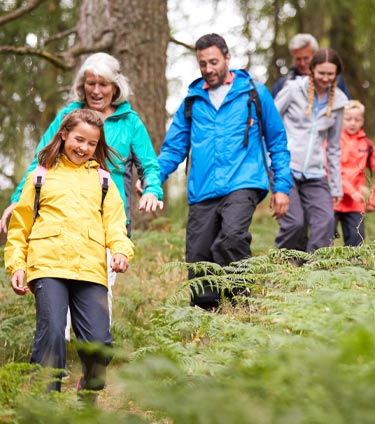

Prevent sunburns. Choose a sunscreen with:
- Broad-spectrum coverage which protects against both UVA and UVB rays.
- Water resistance on the label. These products provide protection for either 40 or 80 minutes on wet skin.
- Sun Protection Factor (SPF) of at least 30. The higher the SPF, the greater the UVB ray protection. UVB rays are the main cause of sunburn.
Application is important. Use these pro sunscreen application tips:
- Apply before going outside, even on cloudy days.
- Apply enough sunscreen. About 1 ounce for the adult body, and a nickel-size for the face.
- Rub thoroughly. It takes approximately 15 minutes for sunscreen to fully absorb.
- Remember to apply to all skin not covered by clothing, like the neck, face, ears, head, and feet.
- Apply every two hours or more often if swimming or sweating.
- Check expiration dates. Most sunscreens are good for at least 2-3 years, but exposure to heat for long periods of time can decrease their effectiveness.
- Remember to seek shade and cover up! Especially between 10am and 4pm.
- Do not use sunscreen on infants under 6 months. Instead, avoid sun exposure and use full-covered outfits with SPF fabrics.
Stay hydrated.
With enough water intake, you and your kids will thrive in the summer sun. That’s why we’ve got tips on tap to keep you healthy and hydrated all summer long.
- Carry a water bottle and keep it filled up
- Choose water instead of sugary drinks
- Space out your water intake to drink consistently throughout the day
- Consume foods high in water content, like fruits and vegetables
- Try an electrolyte-enhanced beverage like Gatorade or Liquid IV!
Have a first aid kit.
Kick back and enjoy summer adventures knowing you have the right tools at your fingertips, at home and in the car.
- Assorted bandages, splints, and gauze with adhesive tape
- Antibiotic ointment and hydrocortisone cream
- Sunscreen, aloe vera gel, calamine lotion, petroleum jelly
- Aspirin, ibuprofen, acetaminophen, antacids
- Instant cold packs, absorbent compresses, cotton balls and cotton-tipped swabs
- Scissors and tweezers, disposable gloves
- Hand sanitizer, antiseptic wipes or swabs, eye wash
Cuts & scraps will happen. Here's how to treat!
Summertime means outdoor fun, which means your kiddo might bring home a scraped knee or a minor cut from their play. So here’s what to do:
- Wash hands and the affected area with soap and lukewarm water to prevent infection.
- If bleeding, apply pressure with gauze for at least 1-2 minutes or until the bleeding stops.
- Apply petroleum jelly or antibiotic ointment and cover with a sterile bandage to protect the wound and hasten healing.
- Try an OTC pain medication like acetaminophen or ibuprofen, if needed.
- Seek medical attention if:
- The cut is longer than three-fourths of an inch, greater than a quarter inch deep, or won’t stop bleeding. Stitches may be needed.
- There may be a foreign object embedded in the cut.
- You notice any signs of an infection as the cut heals, such as pus or increased redness, swelling or pain.
Are your vaccines up-to-date?
Get back-to-school ready by getting immunized. Our pharmacists can administer many vaccines your kids may need to go back to school including:
- Chickenpox
- COVID-19
- Hepatitis B
- Flu
- MMR (Measles, Mumps, Rubella)
- Meningococcal (Meningitis)
- Tdap (Tetanus, Diphtheria and Pertussis/ Whooping cough)
Get immunized today. Schedule your appointment.
These articles are not a substitute for medical advice, and are not intended to treat or cure any disease. Advances in medicine may cause this information to become outdated, invalid, or subject to debate. Professional opinions and interpretations of scientific literature may vary. Consult your healthcare professional before making changes to your diet, exercise, or medication regimen.



